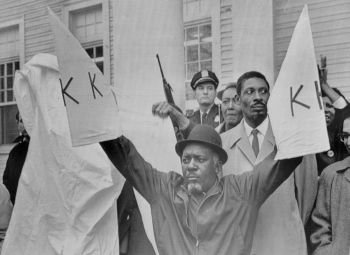
The Deacons for Defense and Justice was an armed self-defense African-American civil rights organization in the Southern states during the 1960s. Historically, the organization practiced self-defense methods in the face of racist oppression that was carried out by Jim Crow Laws; local and state agencies; and the Ku Klux Klan. Many times the Deacons are not written about or cited when speaking of the Civil Rights Movement because their agenda of self-defense, in this case, using violence (if necessary) did not fit the image of strict non-violence agenda that leaders like Dr. Martin Luther King Jr. preached about the Civil Rights Movement.
The Deacons were a driving force of Black Power that Stokely Carmichael echoed. Carmichael speaks about the Deacons when he writes, “Here is a group which realized that the ‘law’ and law enforcement agencies would not protect people, so they had to do it themselves…The Deacons and all other blacks who resort to self-defense represent a simple answer to a simple question: what man would not defend his family and home from attack?” The Deacons, according to Carmichael and many others were the protection that the Civil Rights needed on local levels, as well as, the ones who intervened in places that the state and federal government fell short.
As part of their strategy to intimidate African Americans, the Ku Klux Klan initiated a “campaign of terror” that included harassment, the burning of crosses on the lawns of African-American voters, the destruction (by fire) of five churches, a Masonic hall, and a Baptist center, and murder. These incidents were not isolated but a significant amount of this victimization of African-Americans occurred in Jonesboro, Louisiana in 1964.
Ernest “Chilly Willy” Thomas was born in Jonesboro, Louisiana, and understood the need for protection. Civil Rights organization CORE had a freedom house in Jonesboro which became the target of the Klan. The practice, referred to as “nigger knocking,” was a time honored tradition among whites in the rural South. Because of repeated attacks on the Freedom House, the Black community responded. Earnest Thomas was one of the first volunteers to guard the house. According to Lance Hill, “Thomas was eager to work with CORE, but he had reservations about the nonviolent terms imposed by the young activists. Thomas, who had military training, quickly emerged as the leader of this budding defense organization that would guard the Jonesboro community in the day with their guns concealed and carried their guns openly during the cover of night to discouraged any type of Klan activity.
There is no definitive answer on how the group obtained their name. There are many accounts but according to Lance Hill the most plausible explanation is, “the name was a portmanteau that evolved over a period of time, combining the CORE staff’s first appellation of ‘deacons’ with the tentative name chosen in November 1964: ‘Justice and Defense Club’. By January 1965 the group had arrived at is permanent name, “Deacons for Defense and Justice.” The organization wanted to maintain a level of respectability and identify with traditionally accepted symbols of peace and moral values. As one ex-Deacon wrote in a lyric of a song, “the term ‘deacons’ was selected to beguile local whites by portraying the organization as an innocent church group…”
The work of the Deacons is the subject of a 2003 Television movie, Deacons for Defense. The film bases the story around a white-owned factory that controls the economy of the local society and the effects of racism and intimidation on the lives of the African-American community. The film follows the psychological transition of a family and community members from ones that believe in a strict non-violent stance to ones that believe in self-defense.
The tactics of the Deacons attracted the attention and concern of the Federal Bureau of Investigation, which commenced an investigation of the group. In the years to follow, the Bureau produced more than 1,500 pages of comprehensive and relatively accurate records on the Deacon’s activities, largely through numerous informants close to or even inside the organization. Members of the Deacons repeatedly were questioned and intimidated by F.B.I. agents. One member, Harvey Johnson, was “interviewed” by two agents who asked only about how the Deacons obtained their weapons. No questions about Klan activity or police brutality were ever asked. In February 1965, after a New York Times article was produced about the Deacons, J. Edgar Hoover became interested in the group. Lance Hill offers Hoover’s reaction which was sent to the field offices of the Bureau in Louisiana: “Because of the potential for violence indicated, you are instructed to immediately initiate an investigation of the DDJ [Deacons for Defense and Justice].”As was eventually exposed in the late 1970s, under its COINTELPRO program, the FBI became involved in many illegal activities to spy on and undermine organizations that it deemed “a threat to the American way”. The Deacons, opposing White dominance (which the FBI seemed to conflate with “the American way”), were an organization that fell under this “threat” category for the FBI to spy on and undermine. However, with the advent of other militant Black Power organizations and the Black Power Movement becoming the more visible movement towards the later part of the 1960s, the involvement of the Deacons in the civil rights movement declined (and FBI interference with them did as well), with the presence of the Deacons all but vanishing by 1968.
Roy Innis has said of the Deacons that they “forced the Klan to re-evaluate their actions and often change their undergarments”, according to Ken Blackwell.
Source:


No Comments